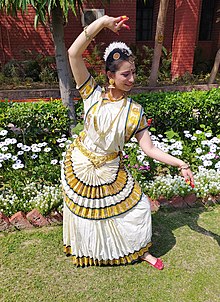

Lasya (Sanskrit: लास्य, romanized: Lāsya) is a female dance form that originated in India.[1] In Hindu mythology, Lasya refers to the dance innovated and performed by the goddess Parvati, described to be gentle and graceful.[2] Described in the Natya Shastra, the feminine Lasya danced by Parvati is contrasted by the masculine Tandava dance of her consort, Shiva.[3][4]
- ^ Arnold, Alison (2017-09-25). The Garland Encyclopedia of World Music: South Asia: The Indian Subcontinent. Routledge. p. 749. ISBN 978-1-351-54438-2.
- ^ Bose, Mandakranta (2012-12-06). Movement and Mimesis: The Idea of Dance in the Sanskritic Tradition. Springer Science & Business Media. p. 152. ISBN 978-94-011-3594-8.
- ^ Masson-Ousel, P.; Stern, P.; Willman-Grabowska, H. (2013-10-11). Ancient India and Indian Civilization. Routledge. p. 375. ISBN 978-1-136-20072-4.
- ^ Ganguly, Anil Baran (1979). Fine Arts in Ancient India. Abhinav Publications. p. 78.